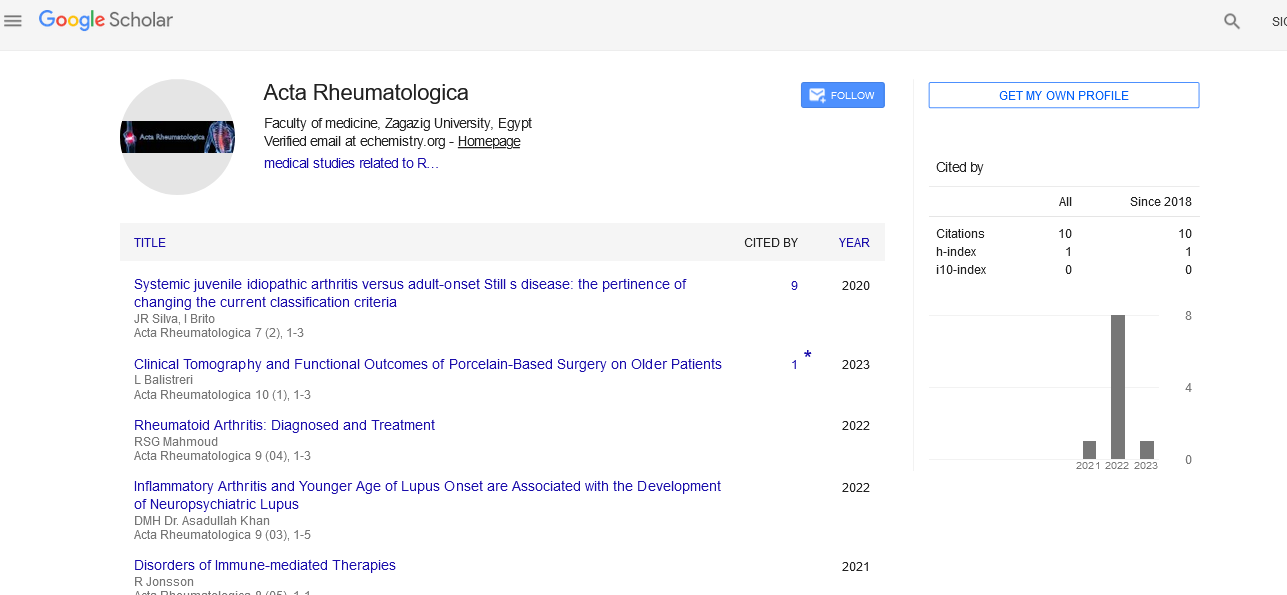Perspective - (2023) Volume 10, Issue 5
Bursitis: Understanding, Managing, and Overcoming Joint Inflammation
Marouane Makhchoune*
Department of Pathology, University Sultan Moulay Slimane, Morocco
*Correspondence:
Marouane Makhchoune, Department of Pathology, University Sultan Moulay Slimane,
Morocco,
Email:
Received: 12-Sep-2023, Manuscript No. ipar-23-14255;
Editor assigned: 15-Sep-2023, Pre QC No. ipar-23-14255 (PQ);
Reviewed: 02-Oct-2023, QC No. ipar-23-14255;
Revised: 10-Oct-2023, Manuscript No. ipar-23-14255 (R);
Published:
18-Oct-2023
Introduction
Bursitis is a common, yet often misunderstood, condition
that affects the body's joints. It's characterized by the
inflammation of the bursae, small fluid-filled sacs that act
as cushions between bones, tendons, muscles, and skin,
reducing friction and allowing smooth movement of the
joints. When these bursae become inflamed, it results in
discomfort, pain, and restricted movement. This article
aims to delve into the intricacies of bursitis, exploring its
causes, symptoms, treatments, and preventive measures.
Understanding bursitis
Bursitis occurs when the bursae become irritated or
inflamed due to repetitive movement, injury, infection, or
underlying conditions such as arthritis. The most
common locations for bursitis are the shoulder, elbow,
hip, knee, and heel. This inflammation results in pain and
tenderness around the affected joint, and in some cases,
visible swelling or warmth.
Causes and risk factors
Repetitive movement: Activities involving repetitive
motion or pressure on a specific joint can lead to bursitis.
For instance, professions or hobbies that demand
repetitive actions, such as gardening, painting, or playing
certain sports, can increase the risk.
Trauma or injury: Direct trauma or impact to a joint can
lead to bursitis. Falls, sudden impacts, or prolonged
pressure on the joint can cause irritation and inflammation
of the bursae.
Infection: In rare cases, bursitis can develop due to an
infection in the bursae. This usually occurs in the bursae
close to the skin's surface.
Underlying conditions: Medical conditions such as
rheumatoid arthritis, gout, or osteoarthritis can predispose
individuals to bursitis due to increased stress on the joints.
Description
Symptoms of bursitis
The most common symptoms of bursitis include:
• Pain or tenderness around the affected joint
• Swelling and warmth near the joint
• Limited range of motion
• Stiffness, especially in the morning or after prolonged
rest
• Visible redness in the affected area in cases of septic
bursitis (infected bursa)
Diagnosis and treatment
Diagnosing bursitis usually involves a physical examination,
discussing symptoms, and possibly imaging tests like X-rays,
MRI, or ultrasound to rule out other causes. Treatment
often focuses on reducing inflammation and relieving pain.
Rest and activity modification: Resting the affected
joint, and avoiding activities that exacerbate pain, allows
the bursae to heal.
Ice and heat therapy: Applying ice packs to reduce swelling
and heat packs to improve blood circulation can help
manage pain and inflammation.
Pain relievers: Over-the-counter Nonsteroidal Anti-
Inflammatory Drugs (NSAIDs) can help alleviate pain and
reduce inflammation.
Physical therapy: Stretching and strengthening exercises
can improve joint mobility and reduce the risk of future
bursitis.
Corticosteroid injections: In more severe cases, a
healthcare professional may administer corticosteroid
injections to alleviate inflammation and pain.
Aspiration or surgical intervention: If bursitis doesn't
respond to other treatments, draining the bursa fluid or, in
rare cases, surgery may be considered.
Preventive measures
Taking proactive steps to prevent bursitis is vital for
those at risk. Strategies include:
• Avoiding repetitive motions or using protective
equipment during such activities.
• Regular stretching and strengthening exercises to
maintain joint flexibility and strength.
• Using proper techniques when lifting or performing
physical tasks to minimize strain on joints.
• Maintaining a healthy weight to reduce stress on the
joints.
An inflammation of one or more bursae, which are fluidfilled
sacs of synovial fluid within the body, is known as
bursitis. They have a synovial membrane covering them,
and this membrane secretes a lubricating synovial fluid.
The human body has more than 150 bursae. The bursae
are located at the interfaces between internal structures like
tendons and muscles and the bone. A functioning, nearly
frictionless gliding surface developed by healthy bursae
enables everyday movement pleasant. However, bursitis
makes movement uncomfortable and difficult be cause it
affects the inflammatory bursa. Furthermore, the condition
persists because moving tendons and muscles over the
inflamed bursa worsens its inflammation. On e can also
contract muscle. Symptoms and implications Bursitis is
still noticeable in 3D. Surface bursae are typically affected
by bursitis. These include the bursae of the shoulder, knee,
heel, shin, and prepatellar, retrocalcaneal, and pes
anserinus. The spectrum of symptoms includes joint pain
and stiffness, erythema (redness) and localised warmth, as
well as a stinging discomfort surrounding the joint around
the inflamed bursa. W hen this event occurs, the bursa and
the surrounding joint become stiff the next morning, and
the pain is typically greatest during and after activity.
When bursitis affects the shoulder joint, it may also result
in cracking, grinding, or popping seems, or snapping
scapula syndrome. It's sometimes painful to do something.
Conclusion
Bursitis, while a common condition, can significantly
impact one's quality of life by causing discomfort and
restricted movement. Understanding the causes, symptoms,
and treatments for bursitis is essential for managing and
preventing this condition. Seeking medical advice for
persistent or severe symptoms is crucial, ensuring proper
diagnosis and treatment. Adhering to preventive measures
and lifestyle modifications, such as regular exercise and
proper body mechanics, is crucial for reducing the risk of
bursitis and ensuring optimal joint health.





